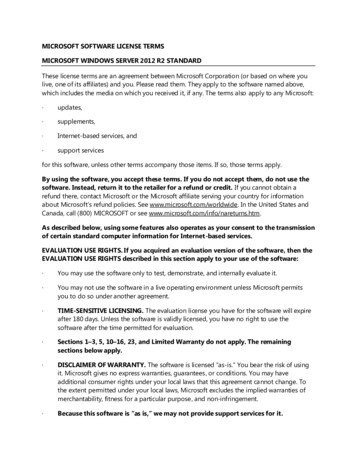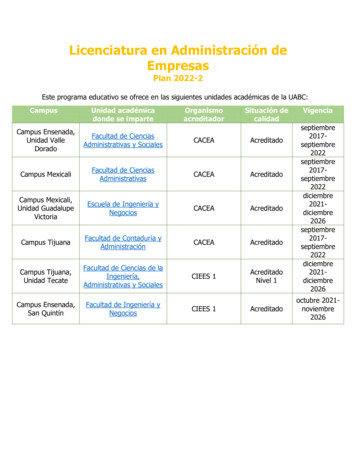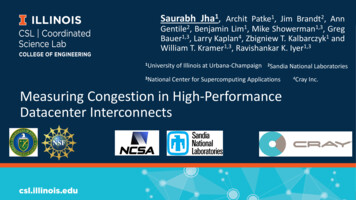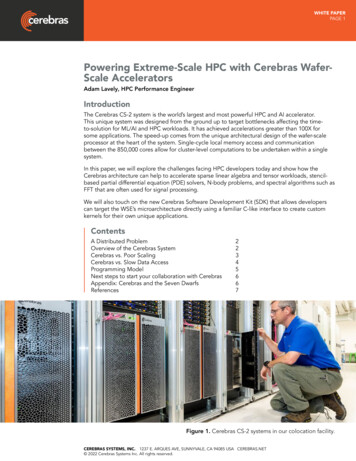
Transcription
Optimizing VM Placement for HPC in the CloudAbhishek Gupta Dejan MilojicicHP Labs Palo Alto, CA, USA(abhishek.gupta2, dejan.milojicic)@hp.comABSTRACT“Computing as a service” model in cloud has encouragedHigh Performance Computing to reach out to wider scientific and industrial community. Many small and mediumscale HPC users are exploring Infrastructure cloud as a possible platform to run their applications. However, there aregaps between the characteristic traits of an HPC application and existing cloud scheduling algorithms. In this paper,we propose an HPC-aware scheduler and implement it atopOpen Stack scheduler. In particular, we introduce topologyawareness and consideration for homogeneity while allocating VMs. We demonstrate the benefits of these techniquesby evaluating them on a cloud setup on Open Cirrus testbed.Categories and Subject DescriptorsD.1.3 [Concurrent Programming]: Parallel Programming;K.6.4 [System Management]: Centralization/decentralizationKeywordsHigh Performance Computing, Clouds, Resource Scheduling1.INTRODUCTIONCloud computing is increasingly being explored as a costeffective alternative and addition to supercomputers for someHPC applications [8, 13, 17, 24]. Cloud provides the benefitsof economy of scale, elasticity and virtualization to HPCcommunity and is attracting many users which cannot afford to establish their own dedicated cluster due to up-frontinvestment, sporadic demands or both.However, presence of commodity interconnect, performance overhead introduced by virtualization and performancevariability are some factors which imply that cloud can be Abhishek, an intern at HP labs, is also a Ph.D. student atUniversity of Illinois at Urbana-Champaign.Permission to make digital or hard copies of all or part of this work forpersonal or classroom use is granted without fee provided that copies arenot made or distributed for profit or commercial advantage and that copiesbear this notice and the full citation on the first page. To copy otherwise, torepublish, to post on servers or to redistribute to lists, requires prior specificpermission and/or a fee.Workshop on Cloud Services, Federation, and the 8th Open Cirrus Summit,September 21, 2012, San Jose, CA, USA.Copyright 2012 ACM 978-1-4503-1267-7 . 10.00.Laxmikant V. KaléUniversity of Illinois at Urbana-ChampaignUrbana, IL 61801, USAkale@illinois.edusuitable for some HPC applications but not all [8, 15]. Pastresearch [15,16,18,24] on HPC in cloud has primarily focusedon evaluation of scientific parallel applications (such as thosewritten in MPI [6]) and have been mostly pessimistic. Tothe best of our knowledge, there have been few efforts on VMscheduling algorithms which take into account the nature ofHPC application - tightly coupled processes which performfrequent inter-process communication and synchronizations.VM to physical machine placement can have a significantimpact on performance. With this as motivation, the primary question that we address through this research is thefollowing: Can we improve HPC application performance inCloud through intelligent VM placement strategies tailoredto HPC application characteristics?Current cloud management systems such as Open Stack [3]and Eucalyptus [23] lack an intelligent scheduler for HPCapplications. In our terminology, scheduling or placementrefers to selection of physical servers for provisioning virtualmachines. In this paper, we explore the challenges and alternatives for scheduling HPC applications on cloud. Weimplement HPC-aware VM placement strategies - specifically topology awareness and hardware awareness in OpenStack scheduler and evaluate their effectiveness using performance measurement on a cloud, which we setup on OpenCirrus [9] platform.The benefit of our approach is that HPC-aware scheduling strategies can result in significant benefits for both HPCusers and cloud providers. Using these strategies, cloudproviders can utilize infrastructure more and offer improvedperformance to cloud users. This can allow cloud providersto obtain higher profits for their resources. They can alsopass some benefits to cloud users to attract more customers.The key contribution of this work is a novel scheduler forHPC application in cloud for Open Stack through topologyand hardware awareness.We address the initial VM placement problem in this paper.The remainder of this paper is organized as follows: Section 2 provides background on Open Stack. Section 3 discusses our algorithms followed by implementation. Next,we describe our evaluation methodology in Section 4. Wepresent performance results in Section 5. Related work isdiscussed in section 6. We give concluding remarks alongwith an outline of future work in Section 7.2.OPEN STACK SCHEDULEROpen Stack [3] is an open source cloud management system which allows easy control of large pools of infrastructure resources (compute, storage and networking) through-
out a datacenter. Open Stack has multiple projects, eachwith a different focus, examples are compute (Nova), storage(Swift), Image delivery and registration (Glance), Identity(Keystone), Dashboard (Horizon) and Network Connectivity (Quantum).Our focus in this work is on the compute component ofOpen Stack, known as Nova. A core component of a cloudsetup using Open Stack is the Open Stack scheduler, whichselects the physical nodes where a VM will be provisioned.We implemented our scheduling techniques on top of existing Open Stack scheduler and hence first we summarize theexisting scheduler. In this work, we used the Diablo (2011.3)version of Open Stack.Open Stack scheduler receives a VM provisioning request(request spec) as part of RPC message. request specspecifies the number of instances (VMs), instance type whichmaps to resource requirements (number of virtual cores,amount of memory, amount of disk space) for each instanceand some other user specified options that can be passes tothe scheduler at run time. Host capability data is anotherimportant input to the scheduler which contains the list ofphysical servers with their current capabilities (free CPUs,free memory etc.).Using request spec and capabilities data, the schedulingalgorithm consists of two steps:1. Filtering - excludes hosts which are incapable of fulfilling the request based on certain criteria (e.g free cores requested virtual cores).2. Weighing - computes the relative fitness of filtered listof hosts to fulfill the request using cost functions. Multiple cost functions can be used, each host is first scoredby running each cost function and then weighted scoresare calculated for each host by multiplying score andweight of each cost function. An example of cost function is free memory in a host.Next, the list of hosts is sorted by the weighted score andVMs are provisioned on hosts using this sorted list.There are various filtering and weighing strategies currently available in Open Stack. However, one key disadvantage of the current Open Stack scheduler is that scheduling policies do not consider application type and priorities,which could allow more intelligent decision making. Further, scheduling policies ignore processor heterogeneity andnetwork topology while selecting hosts for VMs. Existingscheduling policies consider the k VMs requested as partof a user request as k separate VM placement problems.Hence, it runs the core of scheduling algorithm k timesto find placement of k VMs constituting a single request,thereby avoiding any co-relation between the placement ofVMs which comprise a single request. Some example of currently available schedulers are Chance scheduler (chooseshost randomly across availability zones), Availability zonescheduler (similar to chance, but chooses host randomlyfrom within a specified availability zone) and Simple scheduler (chooses least loaded host e.g. host with least numberof running cores).3.AN HPC-AWARE SCHEDULERIn this paper, we address the initial VM placement problem (Figure 1). The problem can be formulated as - Map:k VMs (v1 , v2 , ., vk ) each with same, fixed resource requirements (decided by instance type: CPU, memory, disk etc)UserVM Allocation Request(E.g. k VMs of type m1.small)Open StackSchedulerVM PlacementCloud with heterogeneousphysical hardware(processors types)Figure 1: VM Placementto N physical servers P1 , P2 , ., Pn , which are unoccupied orpartially occupied, while satisfying resource requirements.Moreover, our focus is on providing the user a VM placement optimized for HPC.Next, we discuss the design and implementation of theproposed techniques atop existing Open Stack schedulingframework.3.1TechniquesIn this section, we describe two techniques for optimizingthe placement of VMs for an HPC-optimized allocation.3.1.1Topology AwarenessAn HPC application consists of n parallel processes, whichtypically perform inter-process communication for overallprogress. The effect of cluster topology on application performance has been widely explored by HPC community. Inthe context of cloud, the cluster topology is unknown tothe user. The goal is to place the VMs on those physicalmachines which are as close to each other as possible withrespect to the cluster topology. Let us consider a practicalexample - the cluster topology of Open Cirrus HP Labs site- a simple topology, each server is a 4-core node and thereare 32 nodes in a rack, all nodes in a rack are connected bya 1Gbps link to a switch. All racks are connected using a10Gbps link to a top-level switch. In this case, the 10Gbpslink is shared by 32 nodes, effectively providing a bandwidthof 10Gbps/32 0.312 Gbps between two nodes in differentrack when all nodes are communicating. However, the pointto-point bandwidth between two nodes in the same rack is1 Gbps. Hence, it would be better to pack VMs to nodesin the same rack compared to a random placement policy,which can potentially distribute them all over the cluster.3.1.2Hardware Awareness/HomogeneityAnother characteristics of HPC applications is that theyare generally iterative and bulk synchronous, which meansthat in each iteration, there are two phases - computationfollowed by communication/synchronization which also actsas a barrier. The next iteration can start only when all processes have finished previous iteration. Hence, a single slowprocess can degrade the performance of whole application.This also means that faster processors waste lot of time wait-
ing for slower processors to reach the synchronization point.In case of cloud, the user is unaware of the underlyinghardware on which his VMs are placed. Since clouds evolveover time, they consist of heterogeneous physical servers.Existing VM placement strategies ignore the heterogeneityof the underlying hardware. This can result in some VMsrunning on faster processors, while some running on slowerprocessors. Some cloud providers, such as Amazon EC2 [1],address the problem of heterogeneity by creating a new compute unit and allocating based on that. Using a new compute unit enables them to utilize the remaining capacity andallocating it to a separate VM using shares (e.g 80-20 CPUshare). However, for HPC applications, this can actuallymake the performance worse, since all the processes comprising an application can quickly become out of sync dueto the effect of other VM on same node. To make sure the kVMs are at sync, all k VMS need to be scheduled togetherif they are running on heterogeneous platform and sharingCPU with other VMs (some form of gang scheduling). Inaddition, the interference arising from other VMs can havea significant performance impact on HPC application. Toavoid such interference, Amazon EC2 uses a dedicated cluster for HPC [2]. However, the disadvantage of this is lowerutilization which results in higher price.To address the needs of homogeneous hardware for HPCVMs, we take an alternative approach. We make the VMplacement hardware aware and ensure that all k VMs of auser request are allocated same type of processors.3.2ImplementationWe implemented the techniques discussed in section 3.1on top of Open Stack scheduler. The first modification toenable HPC-aware scheduling is to switch to the use of groupscheduling which allows the scheduling algorithm to considerplacement of k VMs as a single scheduling problem ratherthan k separate scheduling problems. Our topology-awarealgorithm (pseudo-code shown in Algorithm 1) proceeds byconsidering the list of physical servers (hosts in Open Stackscheduler terminology). Next, the filtering phase of thescheduler removes the hosts which cannot meet the requesteddemands of a single VM. We also calculate the maximumnumber of VMs each host can fit (based on the number ofvirtual cores and amount of memory requested by each VM).We call it hostCapacity. Next, for each rack, we calculatethe number of VMs the rack can fit (rackCapacity) by summing the hostCapacity for all hosts in a rack. Using thisinformation, scheduler creates a build plan, which is an ordered list of hosts such that if i j, ith host belongs to arack with higher capacity compared to j th host or both hostbelong to same rack and hostcapacity of ith host is greateror equal to that of j th host. Hence, the scheduler placesVMs in a rack with largest rackCapacity and the host inthat rack with largest hostCapacity.One potential disadvantage of our current policy of selecting the rack with maximum available capacity is unnecessarysystem fragmentation. To overcome this problem, we planto explore more intelligent heuristics such as selecting therack (or a combination of racks) with the minimum excesscapacity over the VM set allocation.To ensure homogeneity, the scheduler first groups the hostsinto different lists based on their processor type and thenapplies the scheduling algorithm described above to thesegroups, with preference to the best configuration first. Cur-Algorithm 1 Pseudo code for Topology aware scheduler1:2:3:4:5:6:7:8:capability list of capabilities of unique hostsrequest spec request specificationnumHosts capability.length()f ilteredHostList new vector int rackList new set int hostCapacity new int[numHosts]for i 1 to i numHosts dohostCapacity[i] max(capability[i].f reeCores/request spec.instanceV cpus,capability[i].f reeM emory/request spec.instanceM emory)if hostCapacity[i] 0 thenf ilteredHostList.push(i)end ifrackList.add(capability[i].rackid)end fornumRacks rackList.length()rackCapacity new int[numRacks]for j 1 to j numRacksP dorackCapacity[j] i hostCapacity[i] i such thatcapability[i].rackid jend forSort f ilteredHostList by decreasing order of hostCapacity[j]where j f ilteredHostList. Call this orderofrackCapacity[capability[j].rackid]wherej f ilteredHostList. Call this P relimBuildP lan.buildP lan new vector[int]for i 1 to i numF ilteredHosts dofor j 1 to j hostCapacity[P relimBuildP lan[i]] dobuildP lan.push(P relimBuildP lan[i])end forend forreturn buildP 25:26:27:rently, we use CPU frequency as the distinction criteria between different processor types. For more accurate distinction, we plan on incorporating additional factors such ascache sizes and MIPS.4.EVALUATION METHODOLOGYIn this section, we describe the platform which we setupand the applications which we chose for this study.4.1Experimental TestbedWe setup a cloud using Open Stack on Open Cirrus testbedat HP Labs site [9]. Open Cirrus is a cluster established forsystem level research. This testbed has 3 types of servers: Intel Xeon E5450 (12M Cache, 3.00 GHz) Intel Xeon X3370 (12M Cache, 3.00 GHz) Intel Xeon X3210 (8M Cache, 2.13 GHz)The topology is as described in section 3.1.1.We used KVM [7] as hypervisor since past research hasindicated that KVM is a good choice for virtualization forHPC clouds [25]. For network virtualization, we initiallyused the default network driver (rtl8139 ) but subsequentlyswitched to the virtio-net driver on observing improved network performance (details in section 5). The VMs used forthe experiments performed in this paper were of the typem1.small (1 core, 2 GB memory, 20 GB disk).4.2Benchmarks and ApplicationsFor this study, we chose certain benchmarks and real worldapplications as representatives of HPC applications.
300Bandwidth (Mb/s)Latency (us)25020015010050081632641282565121k2k4k8kMessage Size 10008006004002000Message Size (bytes)Rtl8139 Within NodeRtl8139 Across Node Within RackRtl8139 Across Node Across RackVirtio Within NodeVirtio Across Node Within RackVirtio Across Node Across RackOpen Cirrus Across Node Jacobi2D - A kernel which performs 5-point stencilcomputation to average values in a 2-D grid. Suchstencil computation is very commonly used in scientificsimulations, numerical algebra, and image processing. NAMD [11] - A highly scalable molecular dynamicsapplication and representative of a complex real worldapplication used ubiquitously on supercomputers. Weused the ApoA1 input (92k atoms) for our experiments. ChaNGa [19] (Charm N-body GrAvity solver) - A scalable application used to perform collisionless N-bodysimulation. It can be used to perform cosmologicalsimulation and also includes hydrodynamics. It usesBarnes-Hut tree [10] to calculate forces between particles. We used a 300, 000 particle system for our runs.All these applications are written in Charm [20], whichis a C based object-oriented parallel programming language. We used the net-linux-x86-64 udp machine layerof Charm and used -O3 optimization level.5.RESULTSWe first evaluate the effect of topology-aware scheduling.Figure 2 shows the results of a ping-pong benchmark. Weused a Converse [12] (underlying substrate of Charm )ping-pong benchmark to compare latencies and bandwidthfor various VM placement configurations. Figure 2 presentsseveral insights. First, we see that virtio outperforms rtl8139network driver both for intra-node and inter-node VM communication, making it a natural choice for remainder of theexperiments. Second, there is significant virtualization overhead. Even for communication between VMs on same node,there is a 64 usec latency using virtio. Similarly, for internode communication, VM latencies are around twice compared to communication between physical nodes in OpenCirrus and there is also substantial reduction in achievedbandwidth, although the degradation in bandwidth (33%reduction) is less compared to the degradation in latencies(100% increase). Third, there is very little difference for latencies and bandwidth when comparing communication between VMs on different nodes but same rack and betweenVMs on different nodes on different racks. This can be attributed to the use of wormhole routing in modern network% improvement in Execution TimeFigure 2: Latency and Bandwidth vs. Message Size for different VM placement.22 %20 %18 %16 %14 %12 %10 %8%6%NANCCJJJJMD AMD haN haN acob acob acob acobGGi2i2i2i24c8ore core a4co a8co D-1 D-1 D-4 D-4K4KKKrereco 8co 4co 8corererereApplicationFigure 3: Percentage improvement achieved usinghardware aware Scheduling compared to the casewhere 2 VMs were on slower processors and rest onfaster processorswhich means that the extra hops cause very little performance overhead. As we discussed in section 3.1.1, effectsof intra-rack and cross-rack communication become moreprominent as we scale up or the application performs significant collective communication such as all-to-all data movement.We compared our topology aware scheduler with randomscheduling. To perform a fair comparison, we explicitly controlled the scheduling such that the default (random) casecorresponds to a mapping where the VMs are distributedto two racks, we keep the number of VM on each host astwo in both cases. For the topology aware case, the scheduler placed all VMs to the hosts in same rack. For theseexperiments, we were able to gain up to 5% in performancecompared to random scheduling. We expect the benefits oftopology aware scheduling to increase as we run on highercore counts in cloud.Figure 3 shows the effect of hardware aware VM placement on the performance of some applications for differentnumber of VMs. We compare two cases - when all VMs aremapped to same type of processors (Homo) and when twoVMs are mapped to a slower processors, rest to the fasterprocessor (Hetero). To perform a fair comparison, we keepthe number of VMs on each host as two in both cases. % im-
provement is calculated as (THetero THomo )/THetero . FromFigure 3, we can observe that the improvement achieved depends on the nature of application and the scale at which it isrun. The improvement is not equal to the ratio of sequentialexecution time on slower processor to that on faster processor since parallel execution time also includes the communication time and parallel overhead, which is not necessarilydependent on the processor speeds. We achieved up to 20%improvement in parallel execution time - which means wewere able to save 20% of time * N CPU-hours, where N isthe number of processors used.We used the Projections [21] tool to analyze the performance bottlenecks in these two cases. Figure 4 shows theCPU (VM) timelines for an 8-core Jacobi2D experiment, xaxis being time and y-axis being the (virtual) core number.White portion shows idle time while colored portions represent application functions. For figure 4a, the first 2 VMswere mapped to slower processors and are busy for all thetime. It is clear that there is lot more idle time on VMs 3-7compared to first 2 VMs since they have to wait for VMs 0-1to reach the synchronization point after finishing the computation. The first two VMs are bottleneck in this case andresult in execution time being 20% more compared to thehomogeneous case. In Figure 4b all 8 VMs are on same typeof processors, here the idle time is due to the communicationtime.Figure 5 shows the overall performance that we achieveusing these techniques on our test-bed. We compare theperformance to that achieved without virtualization on thesame testbed. It is clear that using our techniques, evencommunication intensive applications such as NAMD andChaNGa scale quite well, compared to their scalability onthe physical platform. However, effect of virtualization onnetwork performance can quickly become a scalability bottleneck (as suggested by Figures 2 and 4).6.RELATED WORKThere have been several studies on HPC in cloud usingbenchmarks such as NPB and real applications [8, 13, 15–17, 22, 24]. The conclusions of these studies have been thefollowing: Interconnect and I/O performance on commercial cloudseverely limit performance and cause significant performance variability. Cloud cannot compete with supercomputers based onthe metric /GFLOPS for large scale HPC applications. It can be cost-effective to run some applications oncloud compared to supercomputer, specifically thosewith less communication and at low scale.In our earlier work [15], we studied the performance-costtradeoffs of running different applications on supercomputervs. cloud. We demonstrated that the suitability of a platform for an HPC application depends upon application characteristics, performance requirements and user preferences.In another work, we explored techniques to improve HPC application performance in Cloud through an optimized parallel run-time system. We used a cloud-friendly load balancingsystem to reduce the performance degradation suffered byparallel application due to effect of virtualization in cloud.In this paper, we take one step further and research VMplacement strategies which can result in improved applica-(a) Heterogeneous: First two VMs on slower processors(b) Homogeneous: All 8 VMs on same type of processorsFigure 4: Timeline of 8 VMs running Jacobi2D (2Kby 2K): white portion shows idle time while coloredportions represent application functions.tion performance. Our focus is HPC applications - whichconsist of k parallel instances typically requiring synchronization through inter process communication.Existing scheduler do not address this problem. Cloudmanagement systems such as Open Stack [3], Eucalyptus [23]and Open Nebula [5] lack strategies which consider suchtightly coupled nature of VMs comprising a single user request, while making scheduling decisions. Fan et al. discuss topology aware deployment for scientific applicationsin cloud and map the communication topology of a parallel application to the VM physical topology [14]. However,we focus on allocating VMs in a topology aware mannerto provide a good set of VMs to an HPC application user.Moreover, we address the heterogeneity of hardware. Amazon EC2’s Cluster Compute instance introduces PlacementGroups such that all instances launched within a PlacementGroup are expected to have low latency and full bisection10 Gbps bandwidth between instances [2]. It is unknownand undisclosed how strict those guarantees are and whattechniques are used to provide them.There have been several efforts on job scheduling for HPCapplications, such as LSF (Load Sharing Facility) [4] - acommercial job scheduler which allows load sharing usingdistribution of jobs to available CPUs in heterogeneous network. SLURM, ALPS, MOAB, Torque, Open PBS, PBSPro, SGE, Condor are other examples. However, they perform scheduling at the granularity of physical machines. InCloud, virtualization enables consolidation and sharing ofnodes between different types of VMs which can enable improved server utilization.7.CONCLUSIONS AND FUTURE WORKIn this paper, we learned that utilizing the knowledge oftarget application for a VM can lead to more intelligent VMplacement decisions. We made a case for HPC-aware VMplacement techniques and demonstrated the benefits of using HPC-aware VM placement techniques for efficient execution of HPC applications in cloud. In particular, we implemented topology and hardware awareness in Open Stackscheduler and evaluated them on a cloud setup on OpenCirrus testbed.In future, we plan to research how to schedule a mixof HPC and non-HPC applications in an intelligent fashion to increase resource utilization. E.g. co-locating VMs
02-12-22-32-42-5124816326416Execution Time per step(s)2CloudOpen CirrusExecution Time per step (s)Execution Time per step (s)21CloudOpen Cirrus84210.50.2512Number of cores4816Number of cores32642-12-22-32-42-5CloudOpen Cirrus2-62-71248163264Number of cores(a) NAMD (Molecular Dynamics)(b) ChaNGa (Cosmology)(c) Jacobi2D - 4K by 4K matrixFigure 5: Execution Time vs. Number of cores/VMs for different applications.which are network bandwidth intensive and VMs which arecompute intensive to increase resource utilization. Comparison with other network virtualization techniques such asvhost net and tcp protocol is another direction of future research.8.REFERENCES[1] Amazon Elastic Compute Cloud (Amazon EC2).http://aws.amazon.com/ec2.[2] High Performance Computing (HPC) on AWS.http://aws.amazon.com/hpc-applications.[3] Open Stack Open Source Cloud Computing Software.http://openstack.org.[4] Platform Computing. erformance-computing.[5] The Cloud Data Center Management Solution .http://opennebula.org.[6] Mpi: A message passing interface standard. In M. P.I. Forum, 1994.[7] KVM – Kernel-based Virtual Machine. Technicalreport, Redhat, Inc., 2009.[8] Magellan Final Report. Technical report, U.S.Department of Energy (DOE), 2011. http://science.energy.gov/ /media/ascr/pdf/program-documents/docs/Magellan Final Report.pdf.[9] A. Avetisyan et al. Open Cirrus: A Global CloudComputing Testbed. IEEE Computer, 43:35–43, April2010.[10] J. Barnes and P. Hut. A hierarchical O(N log N )force-calculation algorithm. Nature, 324:446–449,December 1986.[11] A. Bhatele, S. Kumar, C. Mei, J. C. Phillips,G. Zheng, and L. V. Kale. Overcoming scalingchallenges in biomolecular simulations across multipleplatforms. In IPDPS 2008, pages 1–12, April 2008.[12] Department of Computer Science,University of Illinoisat Urbana-Champaign, Urbana, IL. The CONVERSEprogramming language manual, 2006.[13] C. Evangelinos and C. N. Hill. Cloud Computing forparallel Scientific HPC Applications: Feasibility ofRunning Coupled Atmosphere-Ocean Climate Modelson Amazon’s EC2. Cloud Computing and ItsApplications, Oct. 2008.[14] P. Fan, Z. Chen, J. Wang, Z. Zheng, and M. R. Lyu.Topology-aware deployment of scientific applicationsin cloud computing. Cloud Computing, IEEEInternational Conference on, 0, 2012.[15] A. Gupta and D. Milojicic. Evaluation of HPCApplications on Cloud. In Open Cirrus Summit (BestStudent Paper), pages 22 –26, Atlanta, GA, Oct. 2011.[16] A. Gupta et al. Exploring the performance andmapping of hpc applications to platforms in the cloud.In Proceedings of the 21st international symposium onHigh-Performance Parallel and DistributedComputing, HPDC ’12, pages 121–122, New York,NY, USA, 2012. ACM.[17] A. Iosup, S. Ostermann, N. Yigitbasi, R. Prodan,T. Fahringer, and D. Epema. Performance Analysis ofCloud Computing Services for Many-Tasks ScientificComputing. IEEE Trans. Parallel Distrib. Syst.,22:931–945, June 2011.[18] K. Jackson et al. Performance Analysis of HighPerformance Computing Applications on the AmazonWeb Services Cloud. In CloudCom’10, 2010.[19] P. Jetley, F. Gioachin, C. Mendes, L. V. Kale, andT. R. Quinn. Massively parallel cosmologicalsimulations with ChaNGa. In IPDPS 2008, pages1–12, 2008.[20] L. Kalé. The Chare Kernel parallel programminglanguage and system. In Proceedings of theInternational Conference on Parallel Processing,volume II, pages 17–25, Aug. 1990.[21] L. Kalé and A. Sinha. Projections : A scalableperformance tool. In Parallel Systems Fair,International Parallel Processing Sympos ium, pages108–114, Apr. 1993.[22] J. Napper and P. Bientinesi. Can Cloud ComputingReach the Top500? In Proceedings of the combinedworkshops on UnConventional high performancecomputing workshop plus memory access worksh
Open Stack, known as Nova. A core component of a cloud setup using Open Stack is the Open Stack scheduler, which selects the physical nodes where a VM will be provisioned. We implemented our scheduling techniques on top of exist-ing Open Stack scheduler and hence rst we summarize the existing scheduler. In this work, we used the Diablo (2011.3)











